Introduction
The Xiaomi Mi 6X has finally gone global and we have a play date with the international Mi A2. Some big shoes it has to fill - the Mi A1 was such a well-rounded yet affordable smartphone that it would regularly feature in our review conclusions as the main alternative for a wide range of competitors. Can the Mi A2 top that?
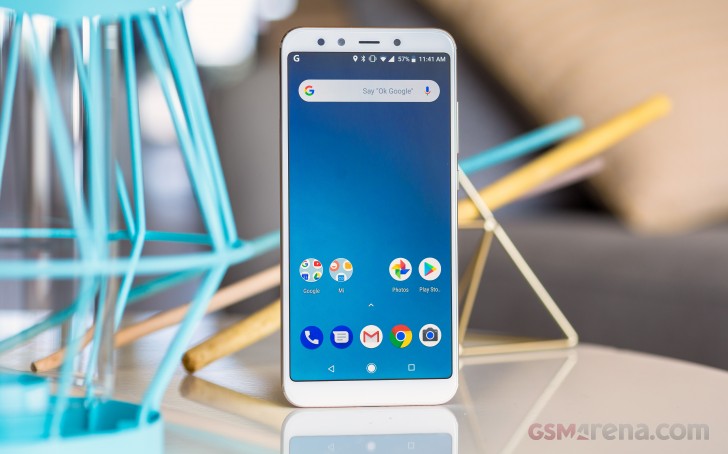
For one, this year's chipset is a notch (or several) up - the Snapdragon 625 in the Mi A1 was all about endurance, while the Snapdragon 660 in the Mi A2 is similarly frugal, only vastly more powerful.
Speaking of notches, there isn't one to spoil the top of the Mi A2's display. It's a contemporary 18:9 unit, the almost-6-inches in diagonal FullHD+ LCD that Xiaomi's already used on a bunch of smartphones. So, that's another one where A2>A1.
More of side step than a definitive improvement is the camera. Gone is the 12MP telephoto module that offered 2x zoom, substituted by a 20MP secondary camera for improved low-light performance (OnePlus-style). The main cam on the back is still 12MP, but now gets a 2/3 of a stop brighter lens (f/1.8 vs. f/2.2). Over on the front, a 20MP selfie cam (same sensor as the one on the rear) replaces the basic 5MP shooter of the Mi A1, and comes with an added flash too.
Xiaomi Mi A2 specs
- Body: Aluminum body.
- Display: 5.99" IPS LCD, 1,080x2,160px resolution, 18:9 aspect ratio, 403ppi.
- Rear camera: Primary 12MP, Type 1/2.9" sensor, 1.25µm pixel size, f/1.75 aperture, PDAF; Secondary 20MP for low-light, Type 1/2.8" sensor, 1.0µm pixel size, f/1.75 aperture, autofocus, pixel binning. 2160p/30fps.
- Front camera: 20MP, 1.0µm pixel size, f/2.2 aperture, Auto HDR, pixel binning. 1080p/30fps video recording.
- OS: Android 8.1 Oreo (part of Android One).
- Chipset: Qualcomm Snapdragon 660: octa-core CPU (4x2.2 GHz Kryo 260 & 4x1.8 GHz Kryo 260), Adreno 512 GPU.
- Memory: 4/6GB of RAM; 32/64/128GB storage; no microSD slot.
- Battery: 3,000mAh Li-Po (sealed); QuickCharge 3.0 fast charging.
- Connectivity: Dual-SIM; LTE, USB-C; Wi-Fi a/b/g/n/ac; GPS; Bluetooth 5.0, IR blaster.
- Misc: Rear-mounted fingerprint reader; single down-firing speaker; no 3.5mm jack (adapter in the box).
Which brings us to the changes that can't really be interpreted as an improvement. Xiaomi might want you to believe that the Mi A2 is now even more affordable, because there's a 32GB storage version, and you also get the option for a fully tricked out 6GB/128GB one for a price premium (the original was only offered in 4GB/64GB trim). What doesn't make it to the press materials is that the microSD slot is now gone. Boo!
Another victim with this generation is the 3.5mm headphone jack - and we thought midrangers were immune from this spreading fad. At least there's an adapter in the bundle.
Xiaomi Mi A2 unboxing
The Mi A2 comes in a rather unusual box as Xiaomi packaging goes - it's not the flat black boxes of the Mi Mixes and the Mi 8, and it's not the bright red packaging of the Redmis either. Instead, it's a white box with a picture of the phone on top and a prominent Android One logo - same as the A1 then.
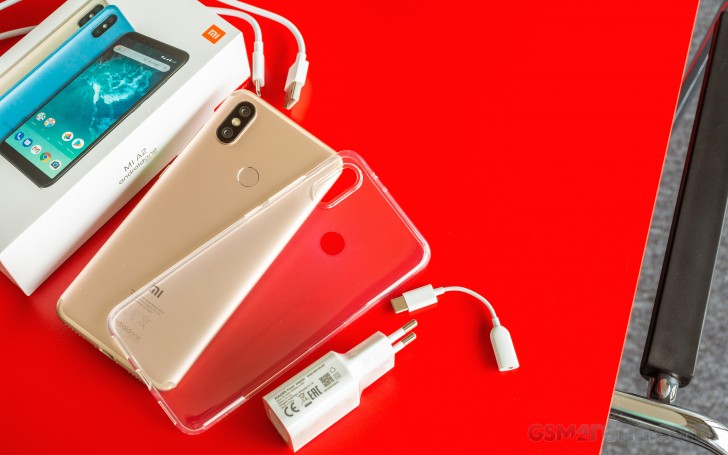
Inside, you'll find the phone, a charger (5V/2A), a USB-C cable to go with it, and the USB-C to 3.5mm dongle we mentioned. With the A2, Xiaomi also throws in a soft silicone case - there was no such treatment for the A1, so that's something.
Let's focus on the phone, though - a bunch of photos and a few words on the design to follow on the next page.
Design and 360-degree spin
One of the Xiaomi MI A2's major visual changes (in more than one sense) from the previous model is the 18:9 display. So Xiaomi is keeping up with the tall aspect trends without going all out and cutting a notch up top - call us backwards all you want, but we prefer it that way. We're fine with the rounded corners, by the way.
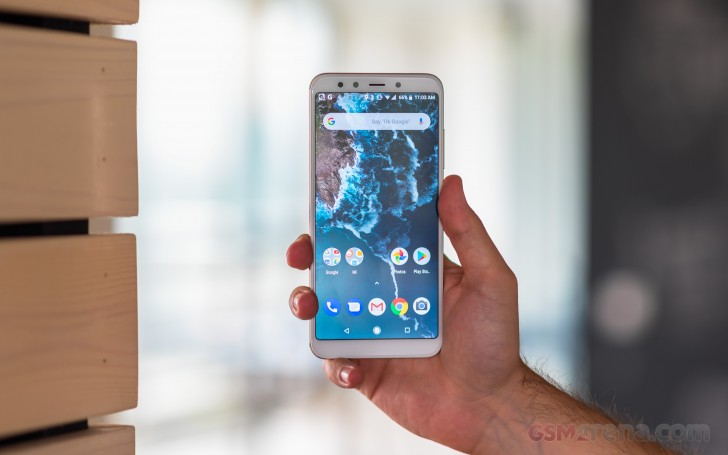
There's nothing backwards about fitting a front-facing flash, and that's exactly what you'd find in the Mi A2's top bezel. It's on the right of the earpiece, while the actual camera is on the left. Another cutout houses the ambient light and proximity sensors, and even if you can't see it, trust us when we tell you that there's a (white-only) status/notification LED next to the flash LED.

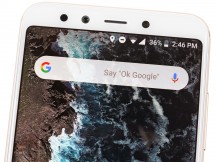
Symmetrical bezels around the 6-inch display • Top one is packed with features
Scoring points for symmetry, the bottom bezel is the same size as the top one, even though there's nothing visibly useful in it (we're sure there's stuff underneath that needs to be there). Speaking of bezels, the Mi A2 is doing much better than the Mi A1, upping the STB ratio by some 10%.
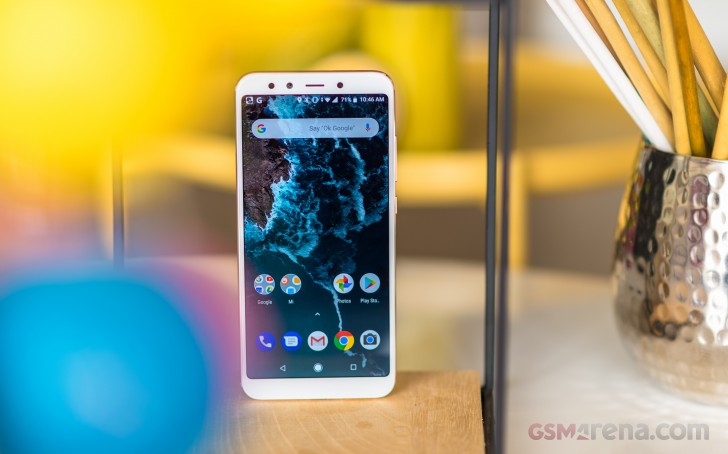
The Mi A2 measures 158.7x75.4x7.3mm, which is 1.3mm taller, as thick, and actually 0.4mm narrower than the model it replaces. And it's got extra screen estate - that's why we have tall screens.
For comparison, the 6-inch Galaxy A6+ (2018) is bigger in every direction (1.5mm taller, 0.3mm wider and 0.6mm thicker), but it does have some extra battery to show for it (3,500mAh). Not quite as much as the Nokia 7 plus (3,800mAh, 8mm), which still manages to fit in virtually the same footprint as the Xiaomi. The Huawei P20 lite, on the other hand, is noticeably more compact - a full centimeter shorter, and 4.2mm narrower, but it's packing a nominally smaller display made even smaller by a notch.
The Mi A2 is also pretty light, its 166g just a gram more than the Mi A1's. Both the Galaxy A6+ (2018) and the Nokia 7 plus are in the 180s, while the P20 lite is ...well... li(gh)ter at just 145g.
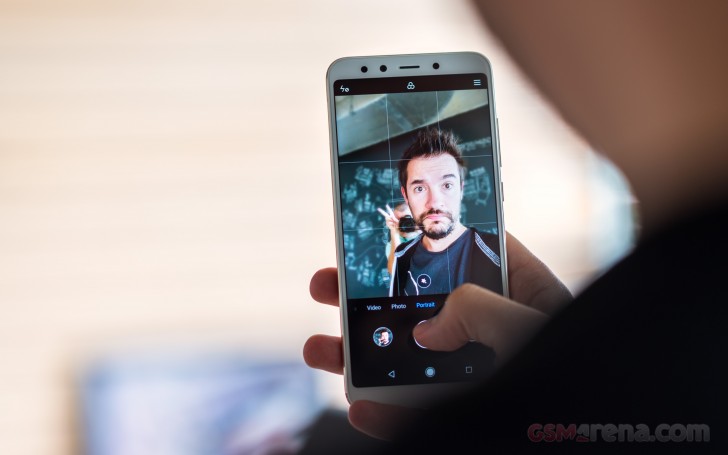
Flipping over to the back, there's a lot of things to see. First up it's the camera in the top left corner - a dual module assembly with a dual LED flash in between. These elements form quite a sizeable bump - it's raised by almost 2mm (we measured 1.8mm, but don't go quoting us on it), and it's one of the wobbliest phones we've had around, if you're one to care.

There's the fingerprint reader on the back, on the central axis and pretty high up, but still in a natural position to comfortably unlock with either index finger. It's only slightly recessed, but there's really nothing to mistake it for, so you can easily find your way by feel.
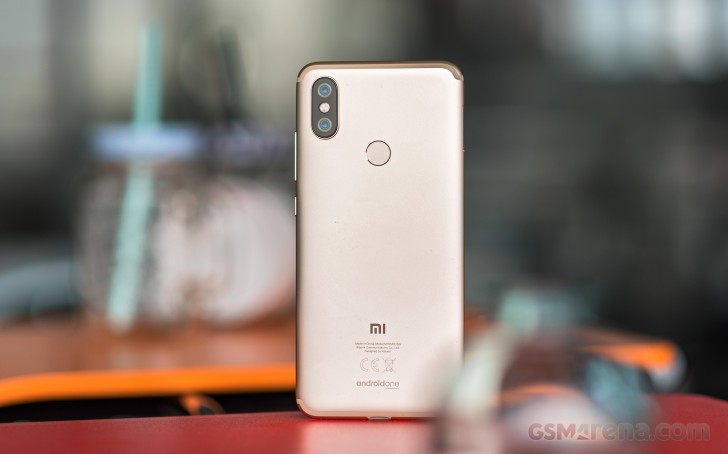
Let's pretend we're showing you the signature Android One logo while we point out the usual pet peeve that we have with pretty much any phone that isn't a Sony - we don't want to be seeing trash cans and regulatory labels and whatnot on our phones. Hide them somewhere already, will you?
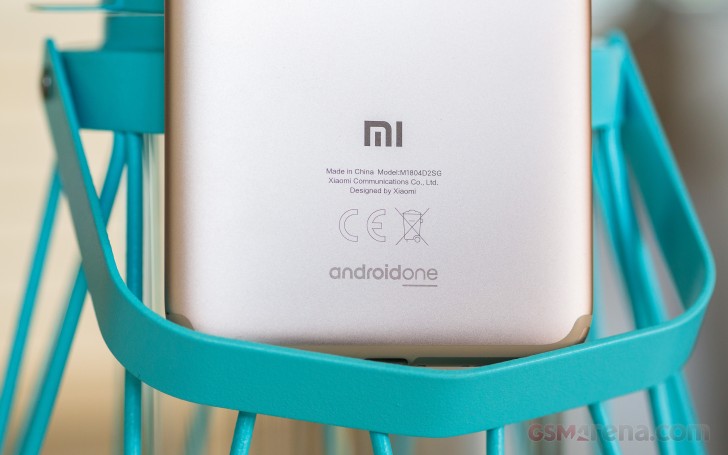
On a more serious note, the Mi A2 is slippery. Not any more so than any other smooth aluminum-backed phone, but 'as slippery' is still pretty slippery. The included soft silicone case helps a ton with providing grip, but be sure to put it on before it's too late. Here's the Mi A2 mid-flight (okay, not really).
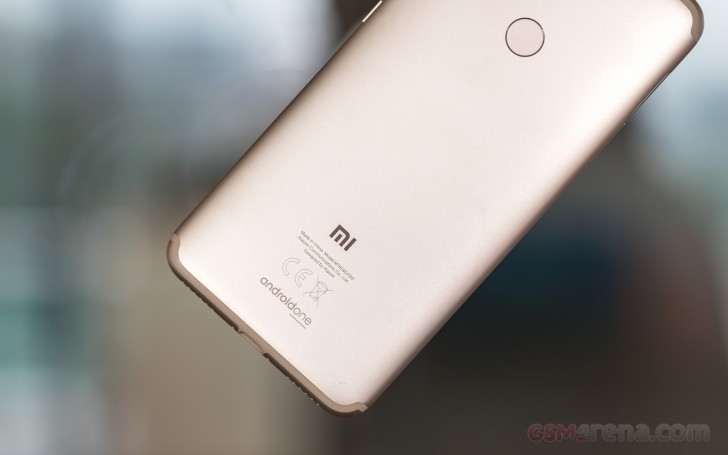
The hardware controls of the Mi A2, all two of them, are on the right - the power button is a bit above the midpoint, the volume rocker above it. Both are reasonably sized and click nicely - no complaints here. The card slot is on the left and it only takes two nanoSIMs - Xiaomi ditched the microSD slot for this generation and we're disappointed, really disappointed.
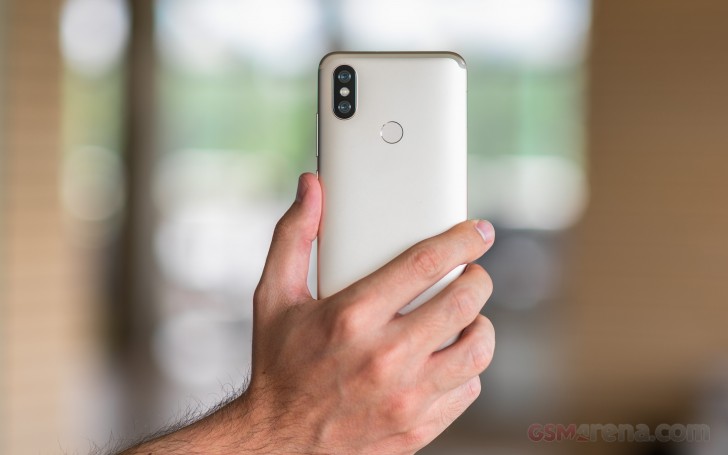
Another feature gone is the 3.5mm headphone jack - apparently, it's not just the flagships that are losing this universal connector. And here we are, naively thinking that mass-market devices were safe. The bundled USB-C-to-3.5mm adapter offers but a little consolation. Oh, it is USB-C (like on the A1, in fact) and that's a good thing - too many phones in the midrange still come with microUSB connectors. Yes, Samsung, we're looking at you and your A6s.

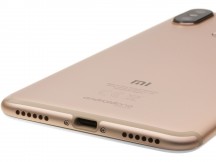
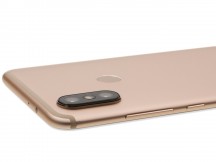
No more microSD • USB-C but no 3.5mm jack • IR emitter up top
One more thing that Xiaomi's kept, and we can't applaud them loud enough for it, is the IR blaster. It's either Huawei or Xiaomi that you need to turn to for it, and even Huawei only puts it on some of its flagships.
Let's go ahead and put on our lab coats and do some testing.
18:9 FullHD+ display, 0.01 short of 6 inches
The Mi A2 comes with what's become Xiaomi's most widely used display configuration, at least looking at the specs. It's a 5.99-inch IPS LCD panel in a 18:9 aspect ratio with 2160x1080px resolution for a pixel density of 403ppi.

In our testing, it put out different results than the ones we saw from two (seemingly) similarly equipped devices, the Redmi Note 5 AI, and the upmarket Mi Mix 2S. The mid-range Mi A2 placed in the middle in terms of contrast, with a very good 1500-ish-to-one, though that's largely thanks to the well controlled deep blacks - the maximum brightness of 420nits is unimpressive. There's no boost when the auto brightness toggle is engaged.
Oddly, the most affordable of the three, the Redmi Note 5, scores highest in both peak brightness and contrast.
| Display test | 100% brightness | ||
| Black, cd/m2 | White, cd/m2 | ||
| 0.375 | 453 | 1208 | |
| 0.28 | 530 | 1893 | |
| 0.47 | 504 | 1072 | |
| 0.277 | 420 | 1516 | |
| 0.278 | 453 | 1629 | |
| 0.311 | 507 | 1629 | |
| 0.404 | 631 | 1562 | |
| 0.367 | 469 | 1278 | |
| 0.228 | 446 | 1956 | |
| 0.418 | 610 | 1459 | |
| 0.564 | 776 | 1376 | |
| 0.27 | 482 | 1785 | |
| 0 | 444 | ∞ | |
| 0 | 387 | ∞ | |
| 0 | 568 | ∞ | |
| 0.254 | 432 | 1701 | |
Sunlight legibility on the Mi A2 is virtually identical to the Mi A1's, which is to say not great, even for an LCD. The Huawei P20 lite is a bit better under direct light, while the Nokia 7 plus is even higher on the sunlight contrast ratio chart and the Moto G6 Plus approaches AMOLED levels.
Sunlight contrast ratio
- Apple iPhone X
5.013 - OnePlus 5T
4.789 - Samsung Galaxy S8
4.768 - Samsung Galaxy S8+
4.658 - Samsung Galaxy S9
4.63 - Samsung Galaxy S6 edge+
4.615 - Samsung Galaxy S9+
4.537 - Motorola Moto Z2 Play
4.459 - Oppo R11
4.454 - Samsung Galaxy S7 edge
4.439 - OnePlus 3
4.424 - Samsung Galaxy S7
4.376 - OnePlus 6
4.321 - HTC One A9
4.274 - Oppo R15 Pro
4.251 - Samsung Galaxy Note7
4.247 - Samsung Galaxy A3
4.241 - Nokia 8
4.239 - Google Pixel 2 XL (pre-update)
4.234 - OnePlus 3T
4.232 - Google Pixel XL
4.164 - ZTE Axon 7
4.154 - Samsung Galaxy Note8
4.148 - Meizu Pro 7 Plus
4.147 - Samsung Galaxy A7 (2017)
4.124 - Samsung Galaxy S6 edge
4.124 - Huawei Mate 10 Pro (normal)
4.096 - Samsung Galaxy Note5
4.09 - Huawei P20 Pro
4.087 - Xiaomi Mi 8
4.086 - Meizu 15
4.082 - Nokia 6 (2018)
4.052 - Google Pixel 2 (pre-update)
4.023 - LG V30
4.022 - Huawei Nexus 6P
4.019 - vivo NEX S
4.012 - Samsung Galaxy J7 Pro
3.998 - Vivo Xplay5 Elite
3.983 - OnePlus X
3.983 - LG G7 ThinQ (outdoor)
3.978 - Oppo R7s
3.964 - Apple iPhone 7
3.964 - Apple iPhone 8 (True Tone)
3.957 - Huawei P9 Plus
3.956 - Meizu Pro 6 Plus
3.935 - Lenovo Moto Z
3.931 - Samsung Galaxy A7 (2016)
3.918 - OnePlus 5
3.914 - Samsung Galaxy C5
3.911 - Xiaomi Mi 8 SE
3.901 - Samsung Galaxy C7
3.896 - Samsung Galaxy A5
3.895 - Samsung Galaxy J7 outdoor
3.879 - Samsung Galaxy J2 outdoor
3.873 - Motorola Moto G6 Plus
3.865 - Samsung Galaxy A8
3.859 - Samsung Galaxy A8 (2018)
3.842 - Samsung Galaxy A6+ (2018)
3.834 - Sony Xperia XZs
3.818 - Samsung Galaxy A9 (2016)
3.817 - Motorola Moto X (2014)
3.816 - Samsung Galaxy J7 (2017)
3.812 - Samsung Galaxy A5 (2017)
3.804 - Samsung Galaxy J7 (2016) outdoor mode
3.802 - Xiaomi Redmi Pro
3.798 - LG V20 Max auto
3.798 - Sony Xperia XZ
3.795 - Samsung Galaxy A5 (2016)
3.789 - Apple iPhone 6s
3.783 - Meizu Pro 5
3.781 - Microsoft Lumia 650
3.772 - Xiaomi Mi 6
3.767 - Sony Xperia XZ1
3.765 - Samsung Galaxy J7 (2016)
3.756 - Nokia 8 Sirocco
3.745 - Sony Xperia XZ1 Compact
3.729 - Apple iPhone 8 Plus (True Tone)
3.725 - Oppo F1 Plus
3.709 - Vivo X5Pro
3.706 - Samsung Galaxy A3 (2017)
3.688 - Huawei P20
3.683 - Apple iPhone SE
3.681 - Huawei Mate 9
3.68 - Samsung Galaxy A7
3.679 - Sony Xperia XZ2 Compact
3.675 - Meizu PRO 6
3.659 - BlackBerry Priv
3.645 - Sony Xperia XA1 Ultra
3.597 - Apple iPhone 7 Plus
3.588 - Sony Xperia XZ2
3.58 - LG G6
3.556 - Apple iPhone 6s Plus
3.53 - Motorola Moto Z Play
3.526 - Samsung Galaxy J3 (2016) outdoor mode
3.523 - Samsung Galaxy J3 (2016)
3.523 - Acer Jade Primo
3.521 - Microsoft Lumia 950
3.512 - Oppo R7 Plus
3.499 - Nokia 7 plus
3.479 - nubia Z11
3.466 - Huawei P10 Plus
3.456 - HTC U Ultra
3.453 - Motorola Moto G6
3.448 - Sony Xperia XA2 Ultra
3.445 - Samsung Galaxy J7
3.422 - Motorola Moto G6 Play
3.419 - Meizu MX5
3.416 - LG V20
3.402 - Samsung Galaxy A6 (2018)
3.397 - Xiaomi Redmi Note 5 AI Dual Camera
3.393 - LG G7 ThinQ
3.39 - Huawei P10
3.379 - Samsung Galaxy J5 (2016)
3.378 - Oppo R9s
3.352 - Honor 8 Pro
3.341 - Oppo F7
3.333 - Oppo R7
3.32 - Lenovo P2
3.316 - Archos Diamond Omega
3.305 - Honor 9
3.289 - Xiaomi Mi 5s
3.276 - Nokia 5
3.261 - Nokia 6 (Chinese version)
3.244 - Xiaomi Mi 5
3.24 - Nokia 6 (Global version)
3.238 - Samsung Galaxy J2
3.235 - Sony Xperia X Performance
3.234 - Xiaomi Mi Note 2
3.228 - Motorola Moto X Play
3.222 - Oppo F3 Plus
3.218 - BlackBerry KEY2
3.212 - Huawei Mate 9 Pro
3.206 - Huawei P9
3.195 - Xiaomi Mi Mix 2
3.19 - ZTE Nubia Z17
3.159 - Oppo R11s
3.153 - Lenovo Vibe Shot
3.113 - HTC U11 Life
3.108 - Motorola Moto X Force
3.105 - LG Nexus 5X
3.092 - HTC U11
3.089 - HTC U12+
3.085 - Xiaomi Redmi S2 (Y2)
3.077 - Huawei Mate S
3.073 - Microsoft Lumia 640 XL
3.065 - Apple iPhone 6 Plus
3.023 - Asus Zenfone 4 ZE554KL
3.019 - Motorola Moto X4
3.012 - Sony Xperia XA1
3.012 - Sony Xperia L1
2.994 - Sony Xperia X
2.989 - LG Q6
2.987 - Huawei P10 Lite
2.974 - Samsung Galaxy Note
2.97 - Huawei P20 Lite
2.952 - Xiaomi Redmi 5
2.951 - Huawei Mate 8
2.949 - Sony Xperia XA2
2.938 - Oppo Realme 1
2.932 - Xiaomi Redmi 4
2.92 - Xiaomi Redmi 5 Plus
2.913 - Xiaomi Redmi 3S
2.913 - Sony Xperia XA Ultra
2.906 - LG G5
2.905 - Huawei Honor View 10
2.896 - Xiaomi Redmi 3s Prime
2.893 - Xiaomi Mi 5s Plus
2.884 - Sony Xperia XZ Premium (sRGB)
2.877 - Sony Xperia XZ Premium
2.877 - Sony Xperia Z5
2.876 - Nokia 3
2.871 - Microsoft Lumia 550
2.851 - Lenovo Moto M
2.813 - Xiaomi Redmi 3 Pro
2.803 - Sony Xperia Z5 compact
2.784 - Honor 10 (Vivid)
2.757 - Nokia 2
2.752 - Meizu MX6
2.751 - LG V10
2.744 - Huawei Mate 10 (normal)
2.742 - Motorola Moto G5S Plus
2.737 - Xiaomi Redmi 3
2.735 - Huawei Honor 7X
2.734 - Xiaomi Redmi Note 4 (S625)
2.714 - Meizu M5
2.71 - Xiaomi Mi A2
2.696 - Sony Xperia M5
2.69 - Xiaomi Mi A1
2.689 - Huawei P9 Lite
2.679 - Xiaomi Redmi 4 Prime
2.679 - vivo V7+
2.671 - Vivo V3Max
2.659 - Xiaomi Mi Mix
2.658 - Huawei Mate 10 Lite
2.654 - Oppo F5
2.653 - Doogee Mix
2.642 - Xiaomi Mi 4i
2.641 - Xiaomi Redmi 4a
2.635 - Xiaomi Mi 5X (Standard)
2.616 - Sony Xperia XA
2.609 - Motorola Moto G4 Plus
2.582 - Motorola Moto G4 Plus (max auto)
2.582 - Meizu M5s
2.58 - Xiaomi Mi 4c
2.574 - LeEco Le Max 2
2.567 - Microsoft Lumia 640
2.563 - Asus Zenfone 3 ZE552KL
2.563 - Huawei P Smart
2.563 - Xiaomi Mi Max 2
2.561 - HTC U11+
2.556 - Xiaomi Redmi Note 5A (Y1)
2.556 - Lenovo K6 Note
2.544 - Lenovo Moto G4
2.544 - Oppo F1
2.528 - Sony Xperia Z5 Premium
2.525 - Huawei Honor 7 Lite / Honor 5c
2.506 - Sony Xperia M4 Aqua
2.503 - BlackBerry Motion
2.494 - Oppo F1s
2.481 - Motorola Moto G
2.477 - Lenovo Vibe K5 Plus
2.473 - Huawei G8
2.471 - Huawei nova
2.467 - Sony Xperia Z
2.462 - Lenovo Vibe K5
2.459 - Meizu m3 max
2.447 - Xiaomi Mi 5X (Auto)
2.417 - HTC 10 evo
2.407 - Huawei Honor 7
2.406 - Vivo V7
2.404 - Sony Xperia E5
2.386 - ZUK Z1 by Lenovo
2.382 - HTC 10
2.378 - Oppo F3
2.376 - vivo V5 Plus
2.371 - Meizu m1 note
2.362 - Huawei nova plus
2.329 - Razer Phone
2.328 - HTC One E9+
2.305 - Alcatel One Touch Hero
2.272 - Sony Xperia L2
2.266 - Lenovo Vibe K4 Note
2.254 - HTC U11+ (EU)
2.253 - Sony Xperia C5 Ultra
2.253 - Xiaomi Redmi Note 3 (MediaTek)
2.249 - Sony Xperia C4 Dual
2.235 - Xiaomi Mi Note
2.234 - Motorola Moto G (2014)
2.233 - LG Nexus 5
2.228 - Huawei P8
2.196 - Meizu M5 Note
2.189 - Huawei Honor 6
2.169 - Xiaomi Redmi Note 2
2.166 - OnePlus Two
2.165 - HTC One X
2.158 - LG Aka
2.145 - Xiaomi Redmi Note 4 (X20)
2.145 - Archos 50 Diamond
2.134 - Xiaomi Redmi Note
2.119 - Xiaomi Mi 4S
2.095 - Acer Liquid X2
2.084 - Huawei P8lite
2.078 - vivo V5
2.059 - Moto G 3rd gen max manual
2.026 - Xiaomi Mi 3
2.001 - Xiaomi Mi Max
1.996 - Sony Xperia E4g
1.972 - OnePlus One
1.961 - Sony Xperia Z2
1.944 - Meizu m3 note
1.923 - Meizu m2 note
1.892 - BlackBerry Leap
1.892 - HTC Butterfly
1.873 - ZTE Nubia Z9 mini
1.759 - Sony Xperia U
1.758 - Asus Zenfone Selfie
1.68 - Motorola Moto E (2nd Gen)
1.675 - ZTE Nubia Z9
1.659 - Jolla Jolla
1.605 - Motorola Moto E
1.545 - Sony Xperia M
1.473 - Sony Xperia L
1.351 - Xiaomi Redmi 2
1.311 - HTC Desire C
1.3 - Nokia X
1.291 - Meizu MX
1.221 - Sony Xperia E
1.215
Color accuracy isn't great on the Mi A2. It's only got the one mode with no option to change the color rendition, and we measured an average DeltaE of 5.9 with a maximum of 11 for white - it's heavily shifted towards blue/purple.
Loudspeaker
The Mi A2 has a single down-firing speaker located behind the right grille on the bottom - there's no stereo action here. Lone it might be, but mighty loud it also is - the A2 scores an 'Excellent' rating, with some of the highest readings we've seen in the voice part of our three-pronged test. It's not very boomy in the low register, but it can fill a small room with sound if need be.
| Speakerphone test | Voice, dB | Ringing |
Overall score | |
| 70.2 | 74.7 | 70.0 | Good | |
| 68.6 | 69.9 | 77.8 | Good | |
| 67.5 | 71.3 | 79.7 | Good | |
| 69.7 | 73.5 | 76.6 | Very Good | |
| 68.1 | 69.6 | 82.2 | Very Good | |
| 66.3 | 71.5 | 84.9 | Very Good | |
| 68.8 | 73.9 | 80.8 | Very Good | |
| 68.4 | 71.6 | 84.8 | Very Good | |
| 68.0 | 73.8 | 84.8 | Very Good | |
| 70.5 | 74.1 | 85.2 | Excellent | |
| 76.3 | 73.4 | 81.1 | Excellent | |
| 77.6 | 74.5 | 80.7 | Excellent | |
| 74.0 | 73.9 | 90.4 | Excellent | |
| 82.2 | 76.1 | 86.8 | Excellent | |
| 89.5 | 72.2 | 89.8 | Excellent |
Xiaomi Mi A2 battery life
The Xiaomi Mi A2 is powered by a 3,000mAh battery, 80mAh less than the stated capacity of the Mi A1's cell. It's the same capacity you'd find in the Huawei P20 lite, while the Moto G6 Plus packs a bit more -
Much like its unremarkable battery capacity, the Mi A2's actual endurance isn't anything spectacular. We clocked 9 hours flat in our video playback test, and half an hour more of web browsing over Wi-Fi - not bad, strictly speaking, but nowhere near class-leading. The Mi A1 could do 2 hours more in video playback, and 4 more in web browsing. A2>A1 in voice calls, though - 22 full hours for the new model vs. 20:11h for the old one.
That's not enough to shift the overall Endurance rating in favor of the A2 - the 73-hour result of the new handset is 14h less than what we got out of the A1.

Our endurance rating denotes how long a single battery charge will last you if you use the Xiaomi Mi A2 for an hour each of telephony, web browsing, and video playback daily. We've established this usage pattern so our battery results are comparable across devices in the most common day-to-day tasks. The battery testing procedure is described in detail in case you're interested in the nitty-gritties. You can also check out our complete battery test table, where you can see how all of the smartphones we've tested will compare under your own typical use.
Xiaomi says the Mi A2 will only come with QuickCharge 4.0 support in India, and not the rest of the world. Even without it, a full charge from flat with the bundled 5A/2A charger took 1:55h, which isn't that bad. A 30-minute charge left the battery at 35%.
Audio quality
The Xiaomi Mi A2 had faultless output with an active external amplifier as far as clarity is concerned. It’s loudness was below average, though, so we can’t give it full points.
Volume isn’t any better with headphones, but on the positive side degradation is minimal. The stereo crosstalk only increases a little and there’s a hint of intermodulation distortion, but the Mi A2 is certainly above average when it comes to accuracy in this case.
| Test | Frequency response | Noise level | Dynamic range | THD | IMD + Noise | Stereo crosstalk |
| +0.02, -0.06 | -91.6 | 91.6 | 0.0018 | 0.014 | -95.3 | |
| +0.08, -0.12 | -92.6 | 92.6 | 0.0028 | 0.120 | -69.0 | |
| +0.06, -0.02 | -96.0 | 96.0 | 3.266 | 0.980 | -95.9 | |
| +0.30, -0.32 | -95.4 | 95.3 | 0.016 | 0.473 | -56.4 | |
| +0.07, -0.03 | -89.7 | 89.9 | 0.0060 | 0.201 | -91.7 | |
| +0.22, -0.21 | -91.6 | 91.0 | 0.016 | 0.305 | -56.2 | |
| +0.01, -0.10 | -92.5 | 92.7 | 0.0019 | 0.0077 | -91.2 | |
| +0.50, -0.20 | -91.4 | 91.8 | 0.0079 | 0.402 | -51.5 | |
| +0.17, -0.03 | -92.0 | 92.1 | 0.0023 | 0.092 | -52.8 | |
| +0.02, -0.31 | -38.8 | 81.7 | 0.0013 | 4.690 | -95.9 | |
| +0.25, -0.23 | -93.3 | 90.4 | 0.0045 | 0.227 | -53.9 |
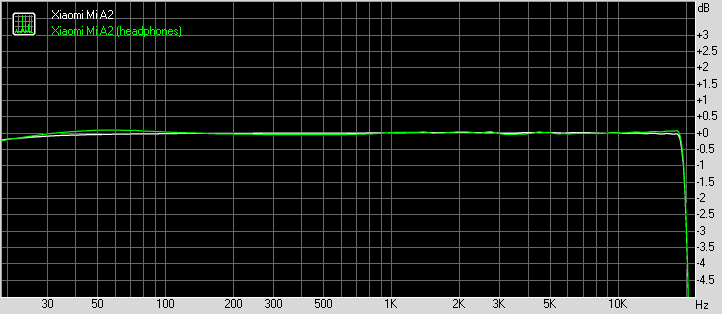
Xiaomi Mi A2 frequency response
You can learn more about the tested parameters and the whole testing process here.
A1 for Android One, A2 - still Android One
The Xiaomi Mi A1 was the company's first smartphone to take part in the Android One program, hence the name. There's no Android Two, so the Mi A2 sticks to Android One - meaning pure Android experience with quick updates as soon as Google's done with them. Sure enough, the Mi A2 we have here is running the latest Android 8.1 Oreo, though it's still on the June 5 security patch for some reason.
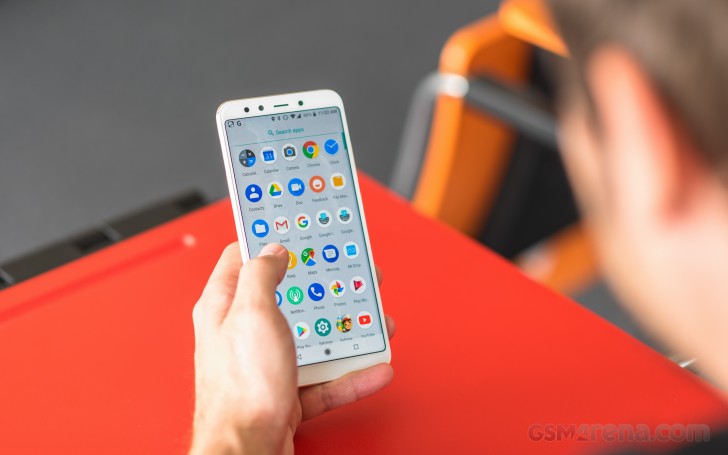
Android as Google intended shows up when you wake up the phone - clock, notification cards, two shortcuts on the bottom. Fingerprint enrollment uses the standard Oreo interface. Unlocking works as advertised and is quick and reliable. Past that is the standard Android 8 homescreen with a pull-up app drawer.





Lockscreen • Fingerprint enrollment • Homescreen • Folder view • App drawer
The quick toggles and notifications shade changes color depending on the wallpaper - white for lighter ones, black for darker ones. A setting for that is coming with Android P, or at least there is one in the beta build. The task switcher is the usual rolodex and wouldn't it be great if Google put the 'clear all' button on the bottom instead of up top? Anyway, multi-window is supported natively since Nougat.
As for gestures, there's the one - double press the power button to launch the camera, if that even counts as a gesture.





Quick toggles • Notifications • Task switcher • Multi-window • Gestures
As for multimedia, it's all in the hands of Google and its default apps. Google Photos is in charge of gallery-related tasks and video playback, while Google Play Music is the audio player, and Google's Calendar is the Mi A2's calendar of choice. The default Files file manager with batch actions and Google Drive sync is present, but let's face it - it's beyond basic.





Google Photos • Google Play Music • Equalizer • Calendar • Default file manager
No wonder then that Xiaomi's added its own, with categories and fancier looks. There's also the Mi Remote app which lets you use the phone's built-in IR emitter to control a wide selection of home appliances - Mi TV's included, naturally. The company's in-house file sharing app Mi Drop is also pre-installed.





Xiaomi File Manager • Mi Remote • Mi Drop
Synthetic benchmarks
While the Mi A1 was using a Snapdragon 625 chip which prioritized power efficiency over absolute performance, for the Mi A2 Xiaomi is using a higher grade 600-series SoC. The Snapdragon 660 packs an octa-core Kryo 260 CPU in a 4x2.2GHz + 4x1.8GHz configuration (8x2.0GHz Cortex-A53 setup in the Mi A1). The Adreno 512 GPU is also a step up from the 506 in the previous model. Now, our review unit is the 4GB version, but a 6GB option will also be available (with 128GB of storage at that).

We've had the Snapdragon 660 in the office on a number of occasions and you'll find the Meizu 15, Nokia 7 plus, and BlackBerry KEY2 in the charts below (plus a couple of Oppos). Popular chips in this segment include the Snapdragon 636 (Redmi Note 5 Pro and AI) and 630 (Nokia 6.1, Moto G6 Plus and X4, and Xperia XA2 Ultra), while Samsung has the brawny Exynos 7885 (Galaxy A8) and the modest 7870 (Galaxy A6) in the midrange. We've thrown Huawei's Kirin 659 and the 970 for comparison's sake, as well as a Mediatek Helio P60 (Oppo R15) and the latest Snapdragon to have - the 710 (Mi 8 SE).
In this unusually varied crowd, the Mi A2 posts scores towards the top of the pack in single-core GeekBench, virtually identical to the rest of its S660 brethren. The Mi 8 SE's S710 has a couple of the more powerful Kryo 360 Gold cores, and one of of those posts noticeably better figures than a Kryo 260 in the A2's S660. Then come the two Helio P60-powered Oppos and the E7885 Galaxy A8 (2018) with their Cortex-A73s, and it's all sorts of Cortex-A53-based chips from then on.
GeekBench 4.1 (single-core)
Higher is better
- Xiaomi Mi 8 SE
1890 - Nokia 7 plus
1634 - BlackBerry KEY2
1628 - Meizu 15
1620 - Xiaomi Mi A2
1617 - Oppo R11s
1614 - Oppo R15 Pro
1612 - Samsung Galaxy A8 (2018)
1532 - Oppo F7
1531 - Oppo R15
1520 - Xiaomi Redmi Note 5 AI Dual Camera
1329 - Xiaomi Redmi Note 5 Pro
1327 - Huawei P20 Lite
938 - Nokia 6 (2018)
882 - Motorola Moto G6 Plus
882 - Xiaomi Mi A1
877 - Sony Xperia XA2 Ultra
866 - Motorola Moto X4
866 - Samsung Galaxy A6+ (2018)
755 - Samsung Galaxy A6 (2018)
733
Weirdly enough, the Mi A2 doesn't remotely reach the results of the other S660 phones in the multi-core portion of GeekBench, and even trails the S636 Redmi Note 5s. Here, the S710 doesn't have any advantage over the S660s.
GeekBench 4.1 (multi-core)
Higher is better
- Xiaomi Mi 8 SE
5908 - Oppo R11s
5907 - Oppo F7
5901 - Nokia 7 plus
5893 - Meizu 15
5877 - BlackBerry KEY2
5830 - Oppo R15 Pro
5809 - Oppo R15
5806 - Xiaomi Redmi Note 5 AI Dual Camera
4918 - Xiaomi Redmi Note 5 Pro
4696 - Xiaomi Mi A2
4625 - Samsung Galaxy A8 (2018)
4418 - Xiaomi Mi A1
4292 - Nokia 6 (2018)
4225 - Sony Xperia XA2 Ultra
4198 - Motorola Moto G6 Plus
4160 - Motorola Moto X4
4136 - Samsung Galaxy A6+ (2018)
3905 - Huawei P20 Lite
3756 - Samsung Galaxy A6 (2018)
3718
It's nice to see the wall of 15fps results from the S660 devices from the offscreen Manhattan runs in GFXBench - the Mi A2 isn't doing anything out of the ordinary with its Adreno 512 here. The Adreno 616 in the S710 shows its muscle with a more than 50% higher score.
There's more variation in the onscreen test with every manufacturer having its own take on the tall screen resolution and the KEY2 actually having a less than FullHD display while the Meizu 15 and the Oppo R11s are classic 16:9 phones. The frame rates reflect that.
GFX 3.1 Manhattan (1080p offscreen)
Higher is better
- Xiaomi Mi 8 SE
23 - Xiaomi Mi A2
15 - Oppo R15 Pro
15 - Nokia 7 plus
15 - BlackBerry KEY2
15 - Meizu 15
15 - Oppo R11s
15 - Oppo F7
12 - Xiaomi Redmi Note 5 AI Dual Camera
10 - Samsung Galaxy A8 (2018)
9.9 - Nokia 6 (2018)
9.9 - Motorola Moto G6 Plus
9.8 - Motorola Moto X4
9.8 - Sony Xperia XA2 Ultra
9.7 - Xiaomi Mi A1
6.4 - Samsung Galaxy A6+ (2018)
6 - Huawei P20 Lite
5.1 - Samsung Galaxy A6 (2018)
3.2
GFX 3.1 Manhattan (onscreen)
Higher is better
- Xiaomi Mi 8 SE
22 - BlackBerry KEY2
17 - Oppo R11s
15 - Meizu 15
15 - Xiaomi Mi A2
14 - Nokia 7 plus
14 - Oppo R15 Pro
12 - Oppo F7
11 - Motorola Moto X4
11 - Sony Xperia XA2 Ultra
10 - Nokia 6 (2018)
10 - Xiaomi Redmi Note 5 AI Dual Camera
9.7 - Motorola Moto G6 Plus
9.3 - Samsung Galaxy A8 (2018)
8.7 - Samsung Galaxy A6 (2018)
6.7 - Xiaomi Mi A1
6.3 - Samsung Galaxy A6+ (2018)
5.6 - Huawei P20 Lite
4.9
It's probably the lower multi-core performance that sets the Mi A2 back in Antutu, where the other S660 devices are again closely packed together, the A2 behind them. The Meizu 15 alone actually scores a tad lower than the Xiaomi, so there's that.
AnTuTu 7
Higher is better
- Xiaomi Mi 8 SE
170218 - Oppo R15 Pro
146526 - BlackBerry KEY2
140984 - Nokia 7 plus
140820 - Oppo R15
140161 - Oppo F7
139414 - Xiaomi Mi A2
130927 - Meizu 15
125444 - Xiaomi Redmi Note 5 AI Dual Camera
115195 - Xiaomi Redmi Note 5 Pro
107737 - Nokia 6 (2018)
90918 - Motorola Moto G6 Plus
90263 - Sony Xperia XA2 Ultra
89110 - Huawei P20 Lite
87431 - Samsung Galaxy A6+ (2018)
69899 - Samsung Galaxy A6 (2018)
63632
Overall, the Mi A2 is a dependable performer thanks to its upper midrange Snapdragon 660 chip. It's a considerable step up from the S625 of last year's model and the S630 and S636 of today's competition. We did observe unusually low multi-core CPU results, but we didn't see that manifest itself as a problem in actual use. Some heat build up was also present with a modest amount of throttling too, but it's nowhere near the worst offenders in this respect.
2x zoom module now gone, replaced by a 20MP one for low light
The Mi A1 came with a 2x12MP camera combo with the two modules' equivalent focal lengths matched in such a way as to produce 2x zoom - same as the iPhone X and Galaxy S9+. With the Mi A2, however, this has changed - the 12MP tele camera has been swapped out for a 20MP secondary cam for improved low-light images, supposedly.

The main cam is different too, sort of. Well, the lens is - the aperture is now f/1.8, giving you a 2.3 of a stop advantage over the Mi A1's f/2.2. Sensor size is 1/2.9" and pixel pitch is 1.25µm. The secondary module has a 1/2.8" sensor with 1.0µm pixels and an f/1.8 aperture lens.
The camera has the modes arranged side by side for you to change by swiping left and right. Sadly, swiping up/down doesn't switch between front and rear camera - there's a button for that. There are toggles for flash mode, HDR, a set of filters and a hamburger shortcut to the settings.

A manual mode is at your disposal too, and in here you can adjust white balance (presets and light temperature), pick a shutter speed (1/1000s to 32s) and ISO (100-3200). You can also set your own focus (in 1-100 'units' between close-up and infinity). You can also manually switch between using the 'regular lens' and the 'low light lens'.
Image quality
The Mi A2 captures pleasing images in good light, but we need to point out one oddity from the get-go - photos taken with HDR enabled are sharper than ones without it. The difference is particularly visible in the foliage and in the dotted pattern of the blinds. Meanwhile, HDR doesn't do much of what it promises, just barely recovering some of the highlights at the expense of darker shadows.
We're liking the color rendition in the Mi A2's shots - we'd call it just the right amount of extra pop on top of real life. Detail is good (again, not as good as in HDR), and noise is practically non-existent. We'd have liked to see a bit wider dynamic range, but it is what it is.
In low light, the Mi A2 doesn't disappoint either and manages to take well exposed photos with good detail and no loss of color saturation.
We played around with the dual camera settings, and took photos of the same scene in Auto, then in Manual with the main cam only and the secondary cam only. As you can see, the Auto ones are clearly superior to the regular ones in manual mode, while the shots taken with just the 20MP cam aren't much good. So, the two cams do work well in tandem.









Low-light camera samples: Auto • Manual, regular lens • Manual, low-light lens
For even more samples, you can check out our hands-on of the Mi A2 from Madrid.
Once you're done with that, do head over to our Photo compare tool for some pixel peeping of our test posters. We've pitted the Mi A2 against the Nokia 7 plus and the Huawei P20 lite, but feel free to experiment.



Xiaomi Mi A2 against the Nokia 7 plus and Huawei P20 Lite in our Photo compare tool
Portrait mode
There's a portrait mode, naturally, and it produces some really nice shots with competent subject separation and convincing background blur. The fact that it's using a relatively wide-angle camera means it's well suited to self portraits (with the rear camera), but also means that you need to get pretty close to get a headshot framing when shooting other people.
You can also use it if you want to emphasize non-human subjects too. As usual, the successful subject recognition will depend of the combination of subject and background, but we found the Mi A2 to work quite well.



Live focus on non-human subjects
Selfies
The Mi A2 comes with a 20MP selfie camera with a 1/2.8" sensor, 1.0µm pixels, and an f/2.2 aperture lens. There's a front-facing flash too. Overall, it's a significant step up from the Mi A1's 5MP setup.
With plenty of light to throw at it, the Mi A2's selfie camera captures amazingly detailed photos. There's some noise, which is to be expected from pixels this tiny and it's not really an issue. Colors are nice too.
As we've previously experienced with small-sensor selfie cams, the one on the Mi A2 has very limited dynamic range, and in trying to fight that it's pretty trigger-happy to engage HDR (Auto is enabled by default) and that leads to softer images - not an issue if you don't look at them at 1:1 magnification.


Selfie samples: HDR Off • HDR On
There's also a portrait mode for selfies - we're past the times when faux bokeh required a dedicated depth sensing cam. The Mi A2 handles subject separation well, and produces convincing background blur.
We mentioned the front-facing flash, and as with pretty much all such implementations, you need to manage your expectations. It won't produce sharp and detailed results in total darkness, but will save a shot that you'd otherwise miss entirely.


Selfie samples, flash: On • Off
Video recording
The Mi A2 records video in both 2160p and 1080p, but only at 30fps - there's no 1080p@60fps. There's image stabilization in 1080p, but not in 2160p, even if the toggle for it remains operational in the higher resolution (it does nothing).
4K videos have a bitrate of around 42Mbps, while 1080p gets 20Mbps flat. Audio is recorded in stereo at 96kbps.
4K videos are nice and detailed, with no noise and true to life color rendition. 1080p isn't anything special - in fact, it's a bit too soft and watercolor-like. Audio is pretty bad, regardless of resolution.
The stabilization in 1080p does quite a great job smoothing out shake and also handles panning competently. The fact that it's not available in 4K means high-res videos while walking are jerky and best avoided.
As usual, we've uploaded short unedited samples straight out of the phone. You can go ahead and download a 2160p (9s, 48MB) clip and a 1080p (9s, 23MB) one and examine on your own.
Finally, a trip to our Video compare tool will give you an idea how the Mi A2 stacks up against the competition in rendering our studio scenes. We've pre-selected the Nokia 7 plus and the Moto G6 Plus, but a different set of phones is only a few clicks away.



Xiaomi Mi A2 against the Nokia 7 plus and Moto G6 Plus in our Video compare tool
Competition
The Mi A2 is a 6-incher with dual camera, Snapdragon 660 and Android One. Now, that's a pretty accurate summary of the Nokia 7 plus too. The Nokia's second rear cam is an arguably more useful telephoto one, and it's also got a microSD slot. Battery life is also superior on the 7 plus. However, the Mi A2's selfies are a touch better, and it's also more affordable off-contract, though the Nokia is probably easier to find subsidized.
The Moto G6 Plus is another viable alternative. You're unlikely to notice the screen is 0.1" smaller, but you'll appreciate its much higher brightness and better sunlight legibility. The G6 Plus is using a less powerful Snapdragon 630 chip, but it'll outlast the Mi A2 in a battery contest with the display on. It's also got a memory card slot, unlike the Xiaomi handset. The Mi A2's camera output is a little better across the board.
If you want to be up to date with current trends, a notched display is a must and none of the above has one. The Huawei P20 lite has got you covered. Mind you, it's a smaller display in a more compact body, so that could settle it for you right there. The P20 lite scores points for storage expansion, but again, you'd probably prefer the Mi A2's images. The P20 lite doesn't record 4K video, which the Xiaomi does. Also, Huawei's 'lite' will take a heavier toll on your wallet.
You could also look into the Oppo F7. This one's display is larger at 6.23 inches, notched too. Expandable storage (dedicated slot, even) and longer battery life are in its favor, while the lack of 4K recording and less than stellar image quality hurt its chances somewhat. Oh, and the in-house ColorOS may not be to everyone's taste.




Nokia 7 plus • Motorola Moto G6 Plus • Huawei P20 lite • Oppo F7
Verdict
The Mi A1 was one of the easiest phones to recommend last year - a complete package at a reasonable price, what's not to like. It's not so easy with the second generation.
A few of the issues you could see right away from the specsheet. Xiaomi's hacked off the microSD slot and the 3.5mm jack - how was that a good idea on a handset that's supposed to have a mass-market appeal?

Our testing brought more troubling findings, however. The display, for one, didn't get us excited one bit - FullHD resolution in a tall aspect is nice, but we like our displays bright and usable outdoors, which the Mi A2's barely is. Battery life is a noticeable step back from the A1 and worse than pretty much any competitor.
There are some good things to be said about the camera, which does take nice photos in good and low light alike. Even so, we're missing the 2x zoom of the A1. The selfie camera on the A2 is a definitive improvement, no complaints there.
Pros
- Android One - pure Android, quick updates
- Really loud loudspeaker
- Good image quality, superb selfie camera
Cons
- Uninspiring battery life
- Dim display, unimpressive sunlight legibility
The Xiaomi Mi A1 was an incredible value proposition in its market segment, the Mi A2 falls somewhat short. It takes away key features like storage expansion and universal headphone connectivity, plus it misses the mark in crucial areas like display and battery life. Affordable as it may be, it wouldn't be our default choice in the midrange quite like the A1 was.






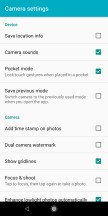



























0 Response to "Xiaomi Mi A2 review"
Post a Comment